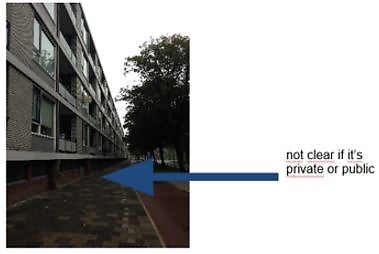Neighborhood safety is a complex problem which consists of many different factors. To start out we did a paper study of the papers: Den Haag in cijfers, Haagse Wijken Monitor and the Strategisch adviesrapport BART. There was a lot of interesting information in these papers, however we had limited time to actually implement an intervention so we decided to focus on specific factors. From the paper of BART we found out that rhythm is important in a neighborhood. We decided to do a study about rhythm for our background studies which can be seen in the following table.
|
Lisa |
Architecture |
|
Jeroen |
Technology Policy and Management |
|
Ahmad |
International Business and Economics |
|
Jun |
Communication Media |
|
Tamara |
Industrial Design Engineering |
|
Joost |
Bio-Pharmaceutical Sciences |
From the architecture study we found out that it is important in a neighborhood that it is clear what kind of function a certain function an area has, such as public, private or semi-public. The paper stated that when a neighborhood has lots of semi-public areas this causes indistinctness. This indistinctness lowers the feeling of safety in the neighborhood.
Also from the architecture study we found out that there is a need for clear routing in a neighborhood, people need to know what they can and can't do at certain areas. However there must not be too many signs like this because the inhabitants of a neighborhood don't like having too many of these signs around.
From the BART study we found out that citizen participation contributes to safety. However citizen participation is hard to maintain for a long period of time.
From the YUPTA framework of BART we found out that the people of Bouwlust did not feel like actively participating in neighborhood safety. So we needed to think about an intervention without active participation of the inhabitants. Also form the YUPTA framework we found out that there was a need for making moments to signify, synchronizing performance and having a comfortable bodysense.
From the economic study we found out that a factor of neighborhood safety is the social cohesion. Social cohesion actually has 3 determinants:
- Opportunity for a population to share the benefits of economic activity.
- Strong sense of personal security.
- commitment to constitutions and institutions.
We focussed on point 2, the strong sense of personal security, which means having a low incidence of crime and other social issues. In the paper of Den Haag in cijfers we found out that bouwlust has one of the highest crime rates. So we believed that this can be lowered by increasing the social cohesion.
But of course social cohesion is also a complex thing, so we thought of factors determining social cohesion. The factors we decided to focus on were rhythm and the sense of pride.
We went to Bouwlust ourselves to inspect the neighborhood and noticed a couple of things that we actually had read about in the papers. One thing we noticed was that there were a lot of signs around that told you what you couldn't do. For instance there was a park where you were not allowed to play football unless you were younger than 12. When questioning people from the neighborhood they told us that this gave a negative vibe to the neighborhood and that they disliked how many of these negative signs were around.
Another thing we saw was that Bouwlust had many undefined places like dead plints which created indistinctiveness and thus lowered the sense of security. These dead plints can be seen in the following picture.
Another thing we noticed is that the houses don't look appealing, this is something we also found in our study because most of the houses were built during the babyboom years so the houses are purely functional and are not there to increase the feeling of the neighborhood.
We thought that having an art route through bouwlust with art created by artists from bouwlust would create a sense of pride while also creating a rhythm. However we also wanted to know what the current rhytm is in bouwlust and what the inhabitants are proud of, and that is where our intervention came in.
